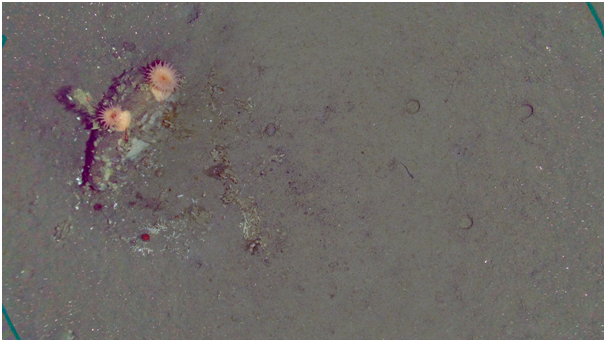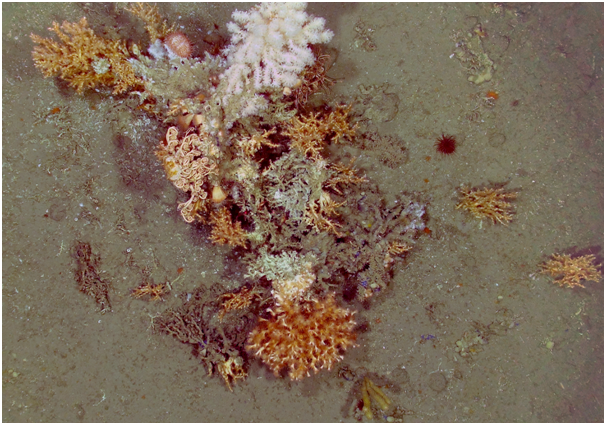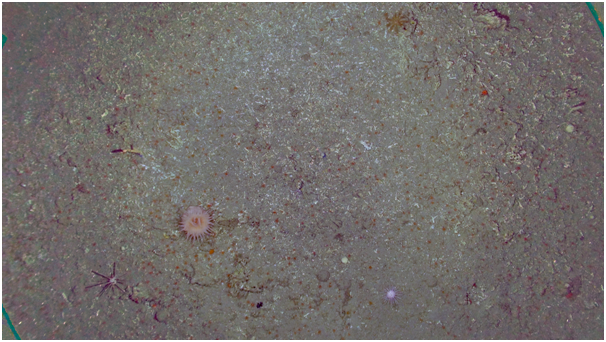On 25 September, early in the morning, HyBIS completed her last dive at the Darwin Mounds. Later on, the Autosub6000 was recovered after a 24-hour survey. After completing some further CTD work for colleagues in NOC, the RRS Discovery is now heading home.
During more than two weeks, we have provided you with outstanding pictures of cold-water coral reefs, showing you one particular facet of the Darwin Mounds environment. However, it is necessary to bear in mind that these reefs characterise only a small fraction of the environment we explored during our expedition on the RRS Discovery. Elsewhere, the seabed habitat hosts different communities, that appear less abundant and diverse at first sight, but are equally important. We hope this blog contribution will better enable the reader to picture what we actually observed at the Darwin Mounds.

Reef-forming cold-water corals and many sponges require specific environmental conditions for settlement, such as the presence of a hard substrate which remains a rare feature of the seabed. In the Darwin Mounds area, our dives allowed us to observe that sand and mud make up the primary substrate of the seafloor, except on the mounds themselves. Reef-forming cold-water corals cannot grow on a soft substrate. This was well observed in our previous blog post as new cold-water corals were growing onto a 8-year old buoy, but none were observed growing on the surrounding seabed. While many organisms can sustain themselves in a soft-substrate environment, the apparent biodiversity remains low compared to what we can see from the pictures of the coral reefs. However, it would be foolish to state that this type of habitat is not biologically interesting. Photographs have limitations in terms of showing the full variety of forms in which Life can occur. For instance, as revealed by the box core operations (cfr. another of our previous blog posts), many tiny organisms thrive in the sediment and they may encompass an equally important part of the life at the Darwin Mounds site.

One must also keep in mind that the Darwin Mounds are structures that are up to 10,000 years old. In the deep-sea, organisms take longer to grow (because of colder temperatures, and less food availability). Reef-forming cold-water corals are slow-growing organisms (±1 cm per year). The building of mound structures, reaching few metres in height as result of the accumulation of dead coral skeleton, remains a long process that can be suddenly stopped by climatic events, and possibly by human disturbance. Thanks to the completion of 13 HyBIS dives (>80 hours of video), we had the chance to observe many mounds. In our blog, we uploaded pictures of healthy corals on mounds as they show the encouraging effects of conservation of the ecosystem in the western Darwin Mounds, and suggest potential for the recovery of the eastern Darwin Mounds after the passage of trawlers early 2000. However, in both eastern and western Darwin Mounds, many mounds were found to host barely or no healthy cold-water coral specimens. As you may understand, it is therefore too early to draw any conclusions regarding the overall coral recovery in the area. Detailed analyses of the video, photographs and samples must be achieved to depict whether we could expect the eastern Darwin Mounds to fully recover from the past anthropogenic perturbation.

Finally, it is important to keep in mind that imaging the deep sea remains a difficult task (see our blog about BioCam). Only a very limited part of the Darwin Mounds has been seen, as only ~0.25% of the area has been imaged in-situ, with a camera. The new BioCAM system offers a major step forward, as we imaged 520,000m2, i.e., twice as much as photographed before, but in less than 48 hours. Even if that dataset is a tremendous asset to undertake detailed scientific analysis, we cannot pretend to fully know the area. For example, the recent discovery of the ‘pocket mounds’, hosting abundant cold-water coral populations (see blog about the pocket mounds), shows how little we know about the ecosystem potential of this Marine Protected Area. As you may have understood throughout this text, since the presence of reef-forming cold-water corals is not so common and since the formation of deep-sea mounds is a very long and uncertain process, it shows the rarity but also the fragility of these biodiverse ecosystems, thus deserving all our effort for protection.
Sadly, we have started our journey to head southward, leaving behind this unique ecosystem still guarding closely its many secrets and keeping its natural treasures from our sight. We will come back, for sure, to learn more about the fascinating life on the seabed in the Darwin Mounds, and to monitor how the MPA evolves over time!

Written by Loic Van Audenhaege and Larissa Macedo.